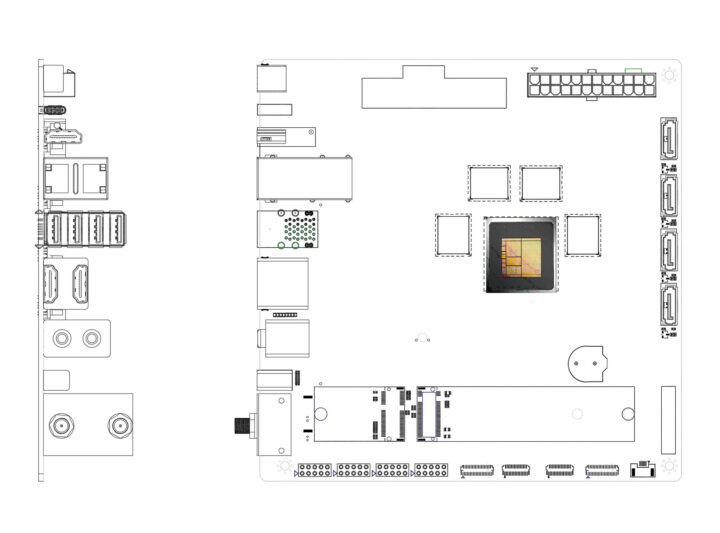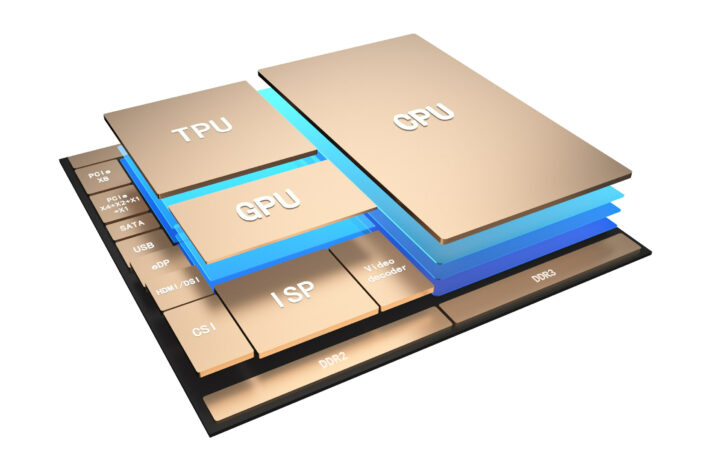Sophgo SG2380 is an upcoming 2.5 GHz 16-core RISC-V processor based on SiFive Performance P670 cores and also equipped with a 20 TOPS AI accelerator using SiFive Intelligence X280 and Sophgo TPU that will find its way into a $120 desktop-class mini-ITX motherboard in H2 2024.
The RISC-V processor also supports up to 64GB RAM, as well as UFS 3.2 and SATA 3.0 storage, comes with an Imagination GPU for 3D graphics and a VPU capable of 4Kp60 H.265, H.264, AV1, and VP9 video decoding, plenty of interfaces, and the system can manage locally deployed larger-scale LLMs like LLaMA-65B without the need for external NVIDIA or AMD accelerator cards.
Sophgo SG2380 RISC-V SoC
Sophgo SG2380 specifications:
- CPU
- 16-core SiFive P670 (RV64GCVH) 64-bit RISC-V processor @ up to 2.5GHz with RISC-V Vector v1.0, Vector Crypto
- Cluster configuration – 12x 2.5 GHz performance cores, 4x 1.6 GHz efficiency cores
- Full RISC-V RVA22 prole compliance
- GPU
- Imagination AXT-16-512 high-mid-performance 3D GPU with support for Vulkan 1.3, OpenGL 3.0, OpenGL ES 3.x/2.0/1.1; 0.5 TFLOPS, 16 Gpixels, and 2 TOPS
- 2D graphic engine
- Video Processing Unit (VPU)
- Up to 4Kp60 10-bit H.265/HEVC, 8-bit H.264/AVC, 8-/10-bit AV1, 8-/10-bit VP9
- No hardware video encoder
- AI accelerators
- 8-core SiFive Intelligence X280 with support for BF16 / FP16 / FP32 / FP64, INT8 up to INT64
- Sophgo TPU coprocessor through VCIX interface up to 20 TOPS @ INT8 compatible with OpenXLA/IREE
- Memory I/F
- Up to 64GB RAM through a 128-bit DDR interface
- Support for LPDDR4 and LPDDR4x 3733Mbps with in–line ECC
- Support for DDR4 UDIMM, SODIMM @ 3200Mbps (no ECC)
- Storage I/F
- Video Output
- eDP 1.2 up to 4Kp60
- DP 1.2 up to 4Kp60 (USB-C Alt mode)
- HDMI 2.0 up to 4Kp60 with CEC and eARC support
- MIPI DSI up to 2Kp60
- Support for dual video output up to 4Kp60
- Camera
- Sophgo AI ISP with dual pipe
- 6x 2-Lane / 4 + 4 x 2 Lane image sensor input
- Interfaces – MIPI CSI2, Sub LVDS, HiSPi
- 2x I2C dedicated to image sensor interface
- Up to 6x 2MP cameras
- Audio
- HD Audio codec
- 3x DMIC
- 3x I2S, 1 of them share pin with HD Audio
- 1x PCM
- Networking – Gigabit Ethernet (RGMII interface)
- USB
- 1x USB 3.2 Gen 1 (5 Gbps) with DP Alt Mode, Power Delivery capable
- 1x USB 3.2 Gen 1 (5 Gbps)
- 2x USB 2.0 interfaces
- PCIe – PCIe Gen3 with 8x+4x+2x+1x+1x Lanes
- Other peripheral interfaces
- 3x SDIO/SD3.0
- 2x CAN 2.0
- 4x UART without trac control function or 2x UART with trac control function
- 8x I2C, SMBUS supported
- SPI/eSPI with 4 CS
- LPC
- PWM
- Fan detect
- Security
- Hardware AES/DES/SHA256
- True Random Number Generator (TRNG)
- Secure key storage, secure boot,
- SiFive WorldGuard
- 32Kb OTP flash
- Power Management – DVFS and ACPI support
- TDP – 5 to 30 Watts
- Junction temperature – -0°C to +105°C
- Package – FCBGA
Sophgo lists a range of applications for its processor, with single board computers, desktop PCs, mini PCs, laptops, workstations, Chromebooks, Android-based tablets, and edge servers (NAS or SMB server).
Oasis mini-ITX motherboard

While the SG2380 SoC will be used for various applications, I expect a range of computers, mini PCs, and laptops considering the geopolitical situation between the US and China, the first platform based on the 16-core RISC-V processor will be the Oasis motherboard.
Oasis specifications:
- SoC – Sophgo SG2380 16-core RISC-V SoC as described above
- System Memory – Up to 64GB 128-bit LPDDR5 5500MT/s
- Storage
- Pluggable UFS module
- microSD card for OS booting and data
- M.2 M-Key socket for NVMe SSD (PCIe 3.0 x4)
- 4x SATA ports for HDD and/or SSD
- Video Output
- 2x HDMI ports up to 4Kp60
- 1x eDP with touch panel
- 2x MIPI DSI connectors
- Camera I/F – 2x MIPI CSI connectors
- Networking
- 2x 2.5GbE RJ45 ports
- 1x M.2 B-Key for 4G / 5G cellular module
- USB – 2x USB 3.0 ports, 2x USB 2.0 ports, 2x front panel USB 2.0 interfaces, 1x USB-C port with DP alt mode
- Expansion
- PCIe x16 slot with PCIe Gen 3 x8 signal
- 8x DIO, 2x CAN Bus
- Dimensions – 17 x 17cm (Mini-ITX form factor)
As you can see from the lack of photos of the board, development is still at the early stage, and the processor and motherboard are only expected in about 9 months (Q3/H2 2024), so I’d assume things may still change a bit, especially for the board.
But if you feel somewhat adventurous, you can already pre-order your Oasis motherboard from Arace for just $0.10 which will give you a coupon code for a 20% discount, or a starting price of starting $120. A few more details may also be found in the announcement.

Jean-Luc started CNX Software in 2010 as a part-time endeavor, before quitting his job as a software engineering manager, and starting to write daily news, and reviews full time later in 2011.
Support CNX Software! Donate via cryptocurrencies, become a Patron on Patreon, or purchase goods on Amazon or Aliexpress





